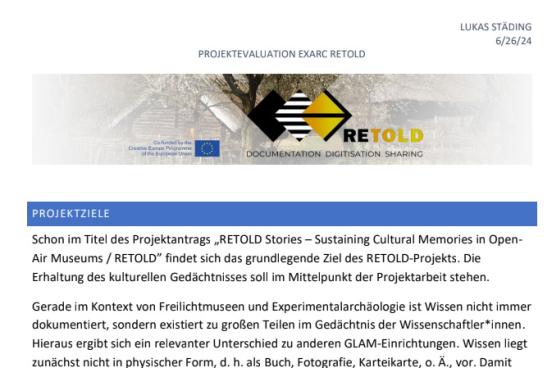
Four years. That is how long the RETOLD project takes. With many goals and a hectic schedule, we may get tunnel vision and forget what we promised, or at least bits of it.
We knew this would be happening, so already before RETOLD started, we had planned an external evaluation during, not after the project. While the financial mid-way audit was done by an accountant, we invited Mr Städing from DigiCULT to evaluate how well RETOLD was on its way to reach its goals. DigiCULT is involved in the development and implementation of German and international digital standards for library and museum documentation. He attended our meeting in Autumn 2023 in Albersdorf and followed the project after that in great detail for a number of months.
Some quotes from his report: "In the case of RETOLD, challenges lie in the linking of material cultural assets (buildings) with intangible cultural assets (craft techniques). The ephemeral nature of intangible knowledge in particular requires particular care in documentation. Unfortunately, international standards in the past have been developed primarily with a focus on physical objects such as art and cultural objects, which makes orientation difficult."
A bit more technical: "The splitting of the various recording objects into independent entities promotes data quality, ensures the (machine) reusability of the data and promotes the acquisition of knowledge through improved retrieval offers in the backend or frontend."
"The statement that can be derived (also mechanically) from this pattern is then the following: 1. A hammer forging type activity took place. 2. The activity was carried out as part of a building (Stone Age House Albersdorf) 3. The activity was carried out in the year 2024 4. A specific forging type technique was used for the forging activity 5. The technique dates back to 500 BC. 6. The activity was carried out by a person named George."
Mr Städing applauds some of the important decisions we have taken over the course of the project, which enables RETOLD to continue developing in a way, which is future proof. Our logic is mostly solid, and we have overcome a number of issues, typically for the open-air museum world. Having done this, we will be able to dock on to the international digital world of the cultural sector.
As he says: "the project already fills a gap in the museum documentation landscape, as the focus is not on physical objects (paintings, vases, etc.), but rather on the intangible knowledge of crafts. Here, the project not only provides impetus for the conception of such a recording practice, but also provides the partners with a practical application."
